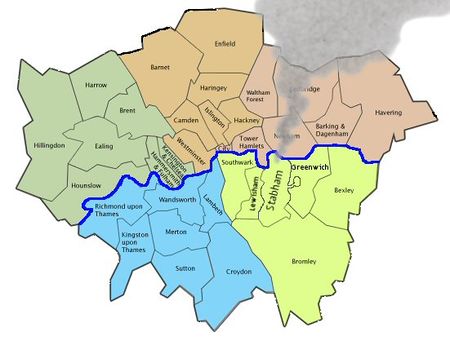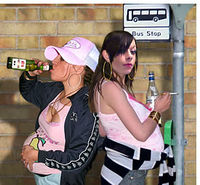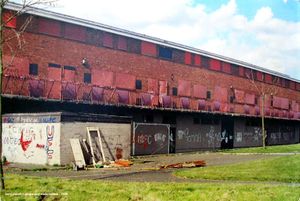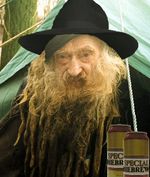Stabham
This article may be Overly British |
The London Borough of Stabham was one of the first areas south of the River Thames to be developed, turning rapidly from a largely rural region to an urbanised concrete jungle during the early years of the 15th Century after the construction of a vast covered market. The diarist Samuel Pepys records it as "a place trodden by onlye its denizens, unwary Yank tourysts and polycemen; ye latter venturing there onlye in groups of ten and having equippeth themseylves with large and Verye Fierce Dogges."
History[edit | edit source]
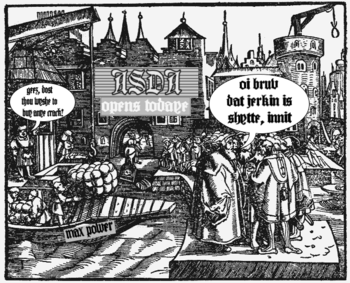
In 1993, archaeologists began work on a unique and fascinating project at Stabham's branch of Carphone Warehouse. During an unsuccessful ram raid on the store, robbers accidentally reversed their stolen Range Rover into what at first glance appeared to be an unremarkable wall, knocking a large lump of render from its surface. An amateur historian spotted what appeared to be medieval script crudely daubed on the bricks beneath and made a note of what he could spell out: "...ves trac...idst...eva" - "...ves...trac...idst...eva." Believing the inscription to be in Latin, a language which he did not speak, he approached the Museum of London to request translation and any further information they might be able to supply.
Experts quickly realised that they too were unable to understand the language, but felt that the wall deserved closer inspection and so work began at the site. Using painstaking techniques, the remaining render was carefully peeled back revealing the words: "bazza loves tracey, idst, 4eva" - "Bazza [Barry] loves Tracey, IDST [if destroyed, still true] 4eva [forever]" - along with a huge amount of contemporary writing. The site was quickly hailed one of the most important archaeological finds ever made in London and following further research has yielded a trove of information. Without it, we would never have been aware that in 15th Century Stabham, it was commonly believed that "Kevin Baileye loveth ye cocke, "alle coppers are bastardes" or that "Ye Millwall FC rule OK."
The history of Stabham as a metropolitan borough begins in 1407 with the opening of the covered market, prior to which the area was rural with large areas given over to the raising of sheep. The market, owned and operated by monks from the nearby Asda Monastery, was for many years after its construction the largest in Europe until superseded in 1569 by a 30,000 square metre Lidl in Copenhagen. Thousands of hand-written leaflets were delivered to homes in north London, proclaiming the market to be "Merrye England's Premiere Retayle Destynationne, for ye supplye of Alle of thine Domestycce Needs. Openne 24 hrs (cafe 9am - 5.30pm excepteth ye Lord's Daye)."
Education[edit | edit source]
Stabham Urban Academy[edit | edit source]
It is an increasingly rare event for any British newspaper to be published that does not contain at least one article on the subject of the nation's failing schools and the unqualified underclass that these establishments produce. Exam pass rates have fallen drastically in the United Kingdom in recent years while at the same time truancy levels have escalated so sharply that 33% of pupils are never in school, 45% regularly miss one day of more in each week, 17% fail to show up for lessons they find particularly difficult or boring, and just 11% are absent only when a legitimate reason - such as illness - prevents them from attending [1].
Crumbling buildings, substandard classroom equipment and poor teaching standards compound the problem to such an extent that many school-leavers find themselves with little hope of gaining productive employment when they enter the world of work. Some may be lucky enough to get unskilled jobs in areas such as the fast food industry, but with positions of this type being hotly sought after by Polish neurosurgeons and other immigrant groups, competition is high and there are simply not enough vacancies to provide employment for all. As a result, vast numbers of young British people are forced to survive on meangre handouts in the form of unemployment benefits.
However, at least one school is bucking the trend and working to find new ways to ensure that pupils are sent out into the adult world well prepared to not only find but to retain careers that will enable them to achieve a higher standard of living. Stabham Urban Academy (SUA), a grant-maintained establishment, has developed a unique and revolutionary syllabus that educates local children in fields which are likely to be of future use to them and which will provide them with the skills they will need to make a living in a modern city environment.
- ↑ This author freely admits to having been one of the 17% who rarely bothered to go to mathematics lessons, a subject he found challenging.
History[edit | edit source]
Established in 1978, SUA began life as a typical modern comprehensive where children were taught a variety of subjects including mathematics, English, history, geography and science. Higher-performing students were encouraged to specialise in the subjects they demonstrated particular aptitude for, and so a child who showed a talent for, as an example, physics would receive more instruction in that subject than one who performed better in geography. By adopting this method, comprehensives were able to turn out sixteen-year-olds who had achieved a good knowledge of at least one subject with a good grounding in the others. This allowed more gifted pupils to apply for places at an adult education centre or as was the case with one pupil in 1983, university; whereas average-performers would be sent out into the workplace with no skills relevant to any form of employment in the area.
Unfortunately, in deprived areas such as Stabham, further education once a child has reached the age of sixteen is in a great many cases simply not a valid option: the father, if he has been present during the child's upbringing, will probably have been made redundant after being replaced in his working capacity by a machine and the mother will often be earning little in an unskilled job such as working in a shop. Furthermore, there is a tradition among Britain's urban working classes whereby parental support of children is cut off once a child reaches this age, allowing the parent to spend a greater percentage of any money they do earn on cheap cider. Also, the majority of sixteen-year-olds will have at least one child of their own. As such, they will often be forced by financial pressure to find paid work so that they can support their families, be that family composed of parents and younger siblings or their own offspring.
Apprenticeships offered hope to many, but Britain's age-old system of apprentice training, run by the Engineering Industry Training Board, came to an end with Margaret Thatcher's abolition of the EITB and similar organisations during the 1980s and 90s after which unqualified school leavers had little chance of learning a trade. Pupils who were simply not academically equipped to get jobs in the newly-emergent industries such as the stock market and hedge fund managership - or those unsuited to such fields due to having souls - rapidly found that they were unable to find any sort of job at all which led to Stabham - in common with many other London boroughs - soon finding itself home to a vast and unemployable underclass.
Temporary Closure and New Horizons[edit | edit source]
Stabham's school was closed following an investigation by Government inspectors in 2002, who reported serious failings at the facility. One inspector wrote: "I can honestly say that, in all my years as an official inspector of educational establishments, I have never seen a school where chaos, violence and anarchy were so rife. I watched in horror as a gang twelve strong hunted down a victim in a corridor and proceeded to empty the poor unfortunate's pockets of change, before they used his own belt to bind him to pipes running along the wall and deliver a savage beating upon him. I called my colleagues to aid me in breaking up the ugly scene - we all received kicks and punches for our trouble. And that was just the teachers; the pupils are even worse."
Further studies proved that the school had achieved the lowest exam results of any European educational facility every year since it was established and that more than 300 people had met their deaths within its classrooms, and so a decision was taken to close the school in order for improvements to be made. Upon closer inspection, it turned out that Stabham pupils were doing particularly well in one area alone - chemistry. This anomaly mystified experts, as exam results in the other sciences were well below average. However, while gathering evidence for their report from former pupils, the inspectors stumbled upon an interesting fact - it was widely recognised throughout South London that Stabham was the source of the best crack and amphetamines available anywhere in the City. The report noted that all illegal drug factories in the borough were run by ex-Stabham School pupils and included the following anonymous statement from one such individual: "Well, rahnd 'ere there ain't much scope fer makin' no money, innit, 'specially if you don't wanna get into twocking motahs an' that. Kids see people wot make the drugs wiv their Beemers an' flashy Fubu gear an' they look up to 'em, like. Drugs ain't sumfink wot's looked dahn on rahnd 'ere - so the young 'uns try to get good and chemistry so that they'll be able to run their own labs when they leave school and stuff."
Since it was well-known that the drugs trade was the only profitable industry in the area, the school was allowed to reopen as a grant-maintained urban academy specialising in the teaching of science. It remains the only British school where children as young as 11 can be seen mixing cocaine[1] with sodium bicarbonate in full view of teachers[2] as they learn different techniques of manufacturing crack or applying red phosphorous to ephedrine as they study the production of methamphetamine.
- ↑ Pupils from poorer backgrounds can apply for state aid in purchasing the raw materials, whereas those with more affluent parents - or whose parents are drug dealers themselves - are expected to supply their own.
- ↑ Crack is made unofficially in many other schools, but generally results in a stern telling-off or even detention after class if detected.
Geography and Ethnic Groups[edit | edit source]
Tribes[edit | edit source]

Stabham is divided between four tribes, with each split into smaller groups. The north of the borough is inhabited by the North Stabham Massive, a generally peaceful tribe though involved in a long-standing, though localised, conflict with the Thames River Police over control of the river's bank which has traditionally been utilised by the NSM as a means of disposing of the corpses of victims. The West Syde B-Bwoys control the second largest region and are characterised by their accents, an imitation of the language used by black American rappers. B-Bwoys also dress like their idols and in many cases attempt to replicate their music, despite the fact that the tribe in primarily formed of white people. All in all, they'd be quite laughable were it not for the fact that many of them have guns. The South Stabham Blade Crew are noted for their beautiful craftsmanship, embodied in the intricate and ornate patterns they commonly carve into the faces of captured members of the WSBB with whom they have been engaged in a long and drawn-out dispute over borders. The last tribal group, the ECSC, make a living from in-car entertainment devices such as CD players which are stolen from vehicles in neighbouring Woolwich and sold on to all of the other Stabham tribes, resulting in the ECSC's very good relations with them.
UN-monitored region[edit | edit source]
In the east of the borough, a thin strip of land - Victoria Avenue - connects Stabham to a small enclave situated within the neighbouring borough of Woolwich. Though defined by the UN - who have been monitoring the area since the mid-1990s in an effort to prevent the sporadic outbreaks of violence that have plagued the area - to be a part of Woolwich, it has been effectively controlled by the ESCS since 1991 after a battalion of Stabham chavs invaded the area following reports that drug dealers in the area were selling skunk at £35 per ounce. The reports turned out to be false (the skunk was, in fact, merely home-grown blockweed with a low THC content), the ECSC has been reluctant to leave the area so as to avoid loss of face and access to Abdul's Kebabs and Burgers Grill which serves food up until 4am every night.
"Psycho" Patel's House[edit | edit source]
Just within the borders of the ECSC region is a small area consisting of one street, a house and a pub. This area has remained independent of tribal control since it is inhabited by Sanjay "Psycho" Patel, a seven-foot tall 28-stone ex-boxer known to be a violent lunatic and avoided by anyone who has any sense of self-preservation whatsoever. During 1987, a warlike group made up of around 150 men - thought to have originated in the south of the borough - armed with baseball bats, iron bars and big dogs attempted to gain control of the street after undercover operatives supplied intelligence that "Psycho" Patel had relocated to Bethnal Green, north of the River Thames. Tragically, the intelligence was not correct and the 150 men have been missing in action ever since, though locals claim that "Psycho" Patel is still eating rottweiler curry to this day.
Landmarks and Local Businesses[edit | edit source]
Landmarks[edit | edit source]
Round the back of the Electricity Sub-Station, Stabham Park should be an unmissable entry on every visitor's Things to See list. This popular venue has been used for many years as a place where Stabham's young people can meet, free from adult interference as it is surrounded on all sides by thick hedges. At around six in the evening on any day of the week, the young ladies of Stabham can be seen dressed in their traditional denim miniskirts, vest tops, Kappa tracksuit jackets and white stiletto shoes as they totter from Raj's Mini-Market to the park with plastic carrier bags filled with bottles of warm Lambrini. Their chatter will be made up chiefly of appraisals of the local boys, whose approval they have come to seek - "That Jamahl from Miss Battersley's maffs class - he's proper lush ain't 'e? I'd fuckin' give anyfink to get 'is cock up me, an' I reckon e'd be a well good dad for my little Charley, Diddy, Brooklyn, Shakira, Kylie and Staffy an' all."
The girls will enjoy one another's company for an hour or two, perhaps indulging in a little character assassination if one of their number appears to have gained a few ounces in weight following the previous Saturday which - as is the case with every Saturday - Stabham's entire under-18 population spent sitting in McDonalds; but before long small groups of teenage boys will begin to arrive, some of them on bicycles or motorbikes "borrowed" from their legal owners. The boys do not drink Lambrini - indeed, to do is considered to attract bad luck, ever since 15-year-old Stabham lad Jamie Hardwick took one sip from his girlfriend's bottle and was immediately stabbed to death by his peers for being a "fuckin' poofter." Instead, they prefer Kestrel lager which can be bought from Raj's at just £5 for eight cans, though those boys that consider themselves to have some degree of class often favour Courvoisier cognac[1], which they pronounce coor-voy-see-er, or Tesco Everyday Value Blended Canadian Whiskey (1 litre for £6.99).
Before long, individuals from each group will begin courting one another. The boys compose beautiful short poems which they recite to the girls such as: "Oi Sharon, gis a nosh you slag or I'll smash your head in," or "Jade you dirty whore, come over here and let me feel yer tits or I'll tell yer dad abaht that time you took it up the arse off them rugby players." The girls, meanwhile, will try to attract the attention of boys they've taken a liking to by sending them pornographic picture messages via their mobile phones. It is not long until the courtship stops and unprotected, underage sex begins.
At 11pm, Jamahl from Miss Battersley's maffs class arrives. Jamahl is slightly older than anyone else present at nearly 17 years of age and is the manager of Stabham's Subway sandwich franchise - as such, he enjoys a disposable income and it is believed that, when his birthday arrives in two month's time and he reaches an age that allows him to start taking driving lessons, he will buy a BMW 3 series with just 75,000 on the clock and alloy wheels. This makes him a sort of king amongst the borough's juvenile population and as such he is afforded the privilege of choosing any of the girls present, each of whom will be more than happy to be his girlfriend even though he'll beat her up regularly.
- ↑ In many cases, this is actually a Chinese copy which they purchase from the ice-cream van that parks up outside Stabham Urban Academy at 4pm every day.
Stinky Jake's Bench, Near The River is home to one of Stabham's best known characters[1], Stinky Jake the Tramp who has lived in the area for longer than anyone can remember - art historians have identified his likeness in an engraving made by William Hogarth circa 1748, where he appears with a large flagon of gin and the same trousers he wears constantly to this day. Stinky Jake is thought to be the source of many of Stabham's myths and urban legends, such as the fire-breathing pigeons with cat's heads that he claimed to have seen in 1995 after he wandered into a local photography studio[2] and drank several bottles of developing fluid.
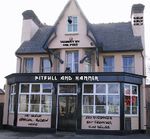
Outside The Pitbull and Hammer, Stabham High Street, 2am on a Sunday Morning: Although Stabham has an amateur football team[1], fighting has always been the area's most popular sport. At around 2am on every Sunday morning, Stabham's favourite pub closes for the night and the young men and women who have been drinking since midday emerge into the street clutching beer bottles and snooker cues. Highly intoxicated, it is not long until tempers fray and arguments flare up. In Stabham, the argument - which in most places serves as a way in which a dispute can be settled by non-physical means - is merely a tradition and is an opportunity for all participants to verbally abuse and anger each other so that the coming fight will be of increased entertainment value for spectators. Before long, a bottle is smashed to indicate the start of the event and within moments harsh blows are being traded. There will be ample opportunity for others to join in - tourists should be aware that if they choose to do so, it is at their own risk. The fight may last for minutes or it might go on for an hour or more, coming to an eventual end only when one combatant lies unconscious in the road. Despite the high risk of injury, this activity remains intensely popular among Stabham residents of both sexes and few of the area's young men and women consider a Saturday night complete until they have been glassed at least twice. Please note that fighting does not take place outside The Pitbull and Hammer on a Saturday morning, as "Psycho Patel" often stops by for a pint of Stella Artois or twenty on his way home from the mosque and you'd have to have a death wish to start kicking off when he's around.
- ↑ The Stabham Schizophrenics - the team has never won a match, but their supporters always win pitched battles between themselves and supporters of other teams/riot police etc.
Local Businesses[edit | edit source]
Other than illicit drug laboratories, crack dealerships and one or two of the more professional muggers, Stabham's most profitable business by far is H. Jenkins and Sons Window Boarding Ltd., which has been trading in the area since the early years of the last century. A walk down Stabham High Street will reveal why the firm has not had to spend any money whatsoever on advertising during its long history - every other shop is boarded up with plywood, each sheet of which is emblazoned with the company's name and telephone number. Now run, you fool - you're standing in the middle of Stabham High Street...do you want to get robbed or what?
Jones Bros. Heroin Wholesale (Private and Trade) occupies a large premises just off the High Street on Rapist's Lane, where it has been situated since 1978 - prior to that date, it had been trading from a stall on Stabham Market since time immemorial. In Victorian times, the firm supplied heroin to Queen Victoria who used it to relieve crippling menstrual pains and, in her own words, "to get right off me tits;" which earned them the right to display a royal crest on their stall and on all company literature. Following the outlawing of heroin use in the 20th Century, the Royals have been keen to distance themselves from the trade but it is thought that Jones Bros. enjoy an exclusive contract to supply the drug to younger members of the family.
Everything's £1!!!!!!! is located three doors down from H. Jenkins. A retailer selling whatever cheap, plastic rubbish they can find being made in the sweatshops of East Asia, every item they stock is - as the firm's name suggests - £1!!!!!!! Customers flock from far and wide to the store, believeing it is a good place to find bargains - unfortunately, they fail to realise that what costs a pound is not necessarily (and, in Everything's £1!!!!!!!, is very rarely) worth a pound.
Raj's Mini-Market sells a wide range of super-strength lager (frequently "on tick" to the local tramps and mad people), knives (no questions asked), long past-the-expiry-date food and pornography. Raj - the owner of the shop - is famous for being the only shopkeeper in Stabham who loses no stock to shoplifters, since it well known that he applies Sharia law to anybody caught stealing in the shop (despite the fact that, being originally from Wembley, he's a Hindu).
